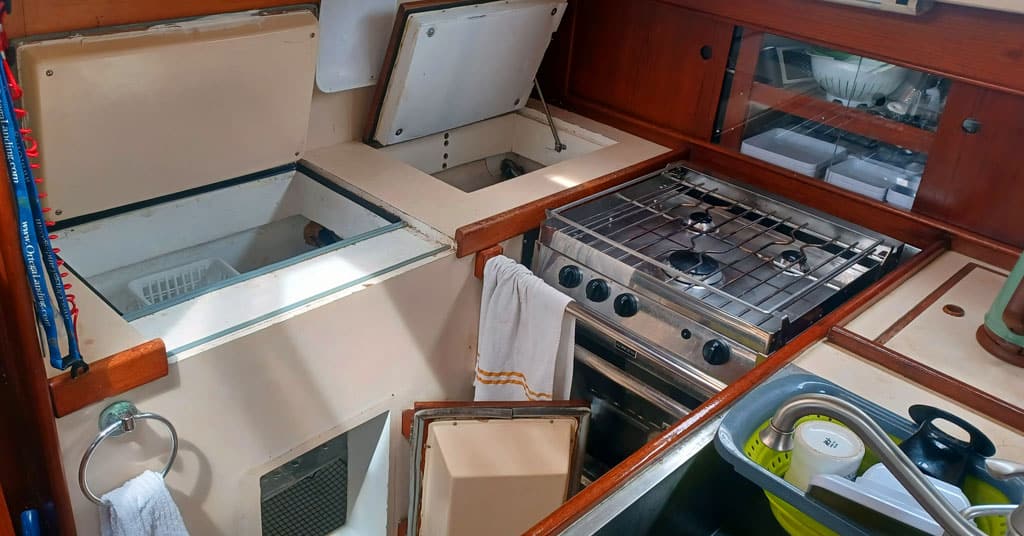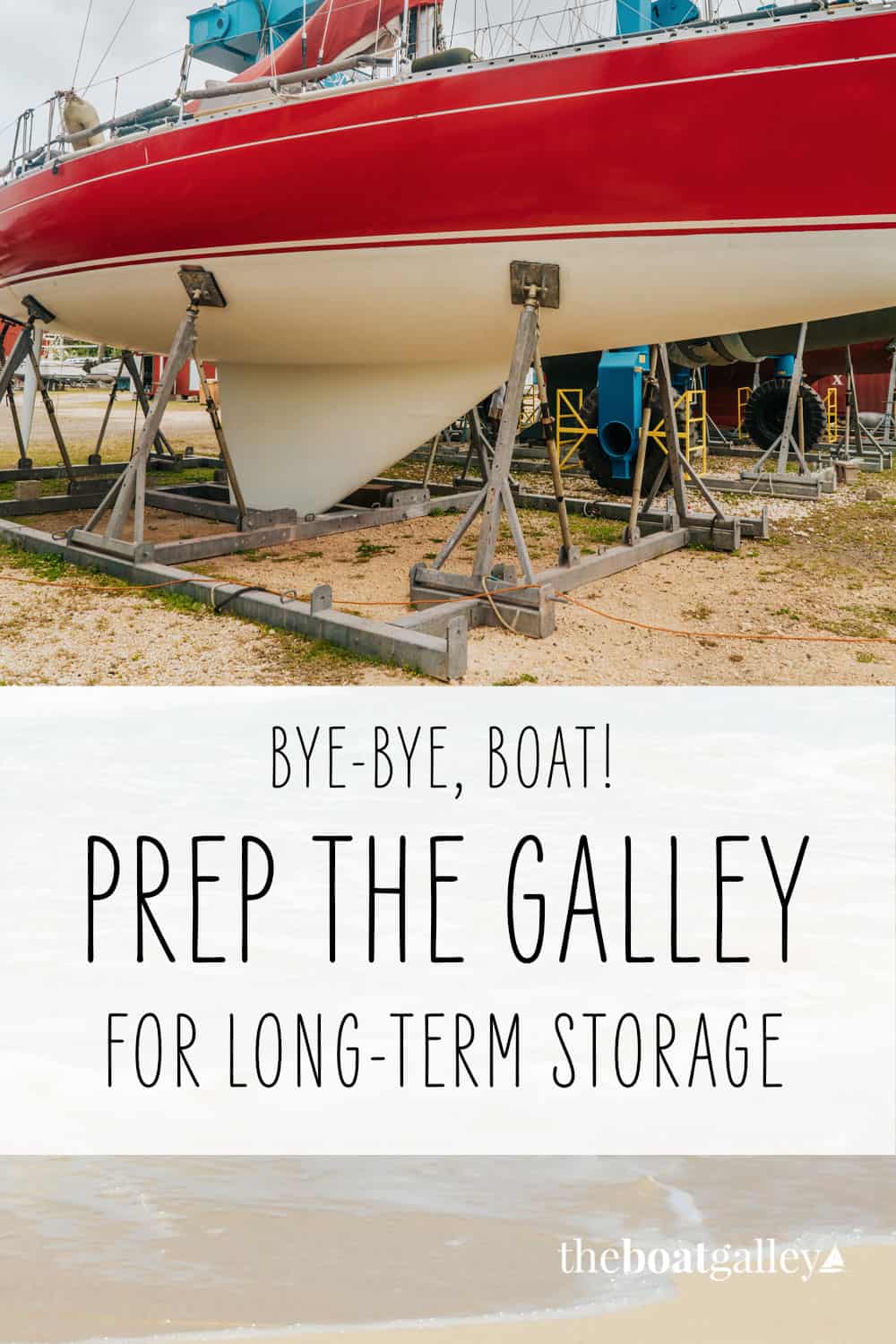Guest post by Jan Irons of CommuterCruiser.com
As commuter cruisers, we leave our 37’ sailboat for six months a year in other countries. My husband David and I have learned the importance of properly preparing the galley to leave the boat.
Sooner or later, even if you’re a full time cruiser, you’ll need to leave the boat for more than just a weekend. In order to return to a boat with no unwanted visitors (rats, mice, cockroaches, ants or other unwelcome surprises) you must properly prepare the galley. After all, the galley is the area most likely to attract unwelcome attention. These ideas may help.
Safety Firs
Turn the propane off at the tank after “bleeding the propane” from the lines. If you don’t bleed the propane every time you use the stove, and you should, here’s the process. First use the stove. Then leave the burner burning and turn the propane off at the solenoid. Wait until the flame goes out. This ensure there’s no propane left in the lines. Then turn the propane off at the tank. Actually disconnect the tank from the boat.
Remove All Food
Remember that all uninvited visitors are looking for one thing . . . a food source. If you don’t provide it, they won’t come. Get rid of anything critters consider food.
When we first left our sailboat in the Rio Dulce, Guatemala, we were ruthless. We got rid of EVERYTHING aboard remotely edible. We donated everything to a local food bank. Although it seemed wasteful at the time, it beat literally throwing it in the trash.
We included every can of food, every spice, every bottle of rum. Make no mistake, a determined rat can chew through just about anything, including floorboards to get to anything it thinks might be edible below. Friends learned this when they accidentally left food under their floorboards. They left the boat on the hard in LaCeiba Boatyard, Honduras to fly home for the holidays. And returned to a complete mess. Get rid of everything!
Back in the US, we are a little complacent. We leave remaining heavy tin cans in a side compartment behind a settee. We probably should get rid of them too. But, as I said, we’re getting complacent.
The question arises, what to do when you’ll just be gone for a month for the holidays. The steps are similar. But we do leave shrink wrapped meats in the freezer. We also leave baking supplies, pasta, and other food in our storage compartments. I always pack them inside large plastic storage containers. But those will not hold up if we were invaded. Friends down the dock last winter after the holidays returned to a rat aboard. If you don’t want surprises, get rid of everything, even if you’ll only be gone for a couple of weeks. We haven’t done this in the past. But after the experience down the dock last winter, we might do things differently this year!
But getting all the food off the boat is only the beginning, there are 4 more critical steps!
Clean, Clean, Clean
After living aboard for six months, even though we maintain relatively clean living quarters, there are always hidden messes. These include crumbs, sticky residue from that glass of spilled lemonade wedged in a floorboard crack, the oven, the stovetop, anywhere there was food. These all provide the potential of “leftovers” enough to attract unwanted attention. I wash every compartment that’s had any type of food out with a bleach water solution. Leave the compartment doors open to let it dry. And then I leave them open while we’re gone just to facilitate airflow.
Don’t forget to defrost and then scrub the refrigerator. Wipe out compartments that contain only storage containers or pots and pans. And make sure all those pots and pans are scrubbed clean.
Another often overlooked area is to wash all the towels, oven mitts, and potholders. Clean anything with food contact. Leave no trace!
Empty Trash
The next step is to empty ALL trash off the boat. Critters enjoy a good mess. Whether it’s food-related or anything, if it’s a big mess, you risk uninvited critters. So thoroughly examine unsuspected places. For us, it’s the sail locker and under the Pullman berth.
Elminate Access from Outside
Next, take steps to uninvite any last minute opportunists that might try to nose aboard anyway by eliminating access from outside. Close the seacocks. Install screens across any ventilation that you’ll be leaving open while you’re gone. Dorades are a prime source of access to the boat; screens work. Make sure areas away from the galley are closed to access as well. One of the primary access areas can be around the windlass/chain locker. If you’re on the hard, block access via thru-hulls.
Use Deterrents
And finally, just before you lock up and walk away, place deterrents around. We use both roach and ant bait hidden in dark corners. And we install most in the galley – under the sink, inside every food storage locker, the fridge, the freezer, the cooler, anything. We also place these inside any compartment in the rest of the boat that had any food storage, including beverages. When we couldn’t buy actual “baits” outside the US, borax works well. We simply saved plastic bottle caps and filled them with borax powder that we purchased from the local farmacia. Some cruisers prefer to mix it with Coffeemate to attract bugs, we just left ours plain.
After last winter’s surprise, some boats we know added rat guards to their lines when they left the boat this year. Because we leave all our lines doubled and the boat in a spiderweb cocoon prepared for hurricane season, David decided that having sealed all the access points to inside the boat, the only thing the rats could do was run around on deck and there’s nothing there for them. I’m hoping when we return to the boat in October that his solution was the right one!
Caretaker
If we’re going to be gone for six months, we never leave without finding someone as a paid caretaker. The responsibilities can be as extensive or as minimal as you want, but having someone look below every week, or every couple weeks can minimize the time any uninvited guests have to exploit their welcome. We ask that our caretaker carefully examine for evidence of rats, mice, cockroaches and other insects.
With proper preparation, you should never have a problem with uninvited critters aboard. Knock on teak, we’ve never had anything worse than an ant infestation in the engine compartment of all places in the 13 years and 15,000 miles we’ve been commuter cruising, six months at a time.
Jan Irons and her husband, David, cruise part-time, six months a year from Annapolis to Cartagena, Colombia and back aboard their 1985 37′ Passport, Winterlude. Jan is the co-author of “The Boat Galley Cookbook” and also the author of CommuterCruiser, a website dedicated to part-time cruisers. For more information on leaving the boat, Jan has checklists on leaving your boat, picking a marina, hurricane preparedness and much more on the “Store Your Boat” section of CommuterCruiser. Check it out!
Read Next

Carolyn Shearlock has lived aboard full-time for 17 years, splitting her time between a Tayana 37 monohull and a Gemini 105 catamaran. She’s cruised over 14,000 miles, from Pacific Mexico and Central America to Florida and the Bahamas, gaining firsthand experience with the joys and challenges of life on the water.
Through The Boat Galley, Carolyn has helped thousands of people explore, prepare for, and enjoy life afloat. She shares her expertise as an instructor at Cruisers University, in leading boating publications, and through her bestselling book, The Boat Galley Cookbook. She is passionate about helping others embark on their liveaboard journey—making life on the water simpler, safer, and more enjoyable.
Simplify meal prep on board with proven strategies for provisioning, maximizing fridge space, and cooking delicious meals aboard your boat.











Jan Irons says
Hi Nicki! I would never leave staples aboard in any container. I’m not sure if you mean the Lock & Lock containers or the new square air tight canisters that claim they’re “flexiglass”. I have heavy plastic square bulk containers for my staples, I never leave anything in them when we leave the boat. While they might be fine for cockroaches and smaller pests, I’ve seen for myself damage done by rats aboard. I have no idea if they’d be able to eat through the canisters, but I wouldn’t take the chance. If we were leaving for a just short time, they might be OK.
Carolyn Shearlock says
Yes, you always want someone to check on the boat at least once a month. Every two weeks is even better.
Dorothy Williams says
Do you have any referrals for boat checking for the 6 months were gone. Havent been able to find anyone that is licensed and insured. Our marina insists on this.
Thanks
Carolyn Shearlock says
It would have to be someone that works at your marina. I’d ask the office who does it for other boats there.
Carolyn Shearlock says
I’m glad to hear they worked well for you. The link is broken — if you’re talking about the disc things that you hang, we tried some about 5 years ago and didn’t see that they were effective on our boat (admittedly, we’re in an extremely hot and humid area). I’ve also seen some “pack” type things that put a chemical into the air — they are really effective but no one can enter until the boat is thoroughly aired out, so you can’t have someone check on your boat. If that the “Sun Pack” you’re talking about, we’ve always thought it was more important that someone be able to come aboard to check the bilges and battery state of charge and so didn’t opt for them.
Carolyn Shearlock says
Try to find a laundromat with large machines — ones that are advertised as 4x or 5x loads. They also may say that they’ll hold a king-size quilt. Dodgers and biminis will usually fit in these. Again, gentle cycle, no dryer.